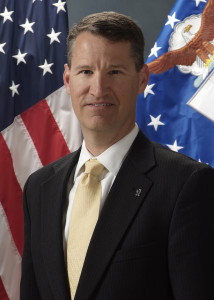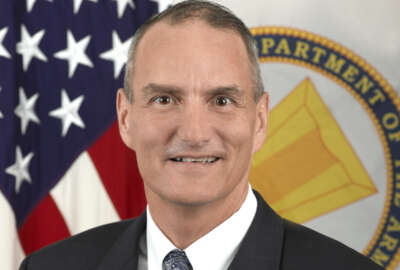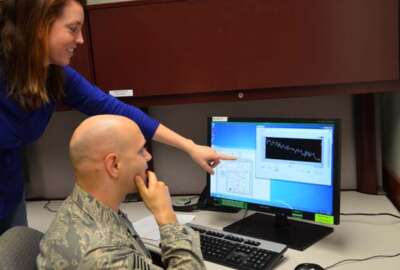
Air Force restructures CIO to bring business, IT and data closer together
Bill Marion, the Air Force’s deputy CIO, said the service hopes to unify technology, data and business transformation from operational and implementation...
Best listening experience is on Chrome, Firefox or Safari. Subscribe to Federal Drive’s daily audio interviews on Apple Podcasts or PodcastOne.
The Air Force is the second military service to restructure its chief information officer’s role by moving it to a higher level in the organization.
The service named Undersecretary Matt Donovan as its new CIO to go along with his current role as the chief management officer.
“What we wanted to do was unify the IT, network modernization and business transformation space so when you think data, you think business systems and you think IT infrastructure all underneath one hat, all underneath the undersecretary,” Bill Marion, the Air Force’s deputy CIO said on Ask the CIO. “It’s very similar to the Navy. We know both from an operational perspective we need to unify and also from an IT implementation perspective where we are tying data all the way back into the network was very critical, especially when you start to get into next generational things like artificial intelligence and machine learning.”

Marion, who returns to his deputy CIO role, had been acting CIO since July when Lt. Gen. Bradford Shwedo became the director for command, control, communications and computers/cyber and chief information officer of the Joint Staff. Marion became deputy CIO in April 2016.
“It brings an elevated view with the undersecretary at the helm as the CIO, CMO and overseeing the chief data officer piece of it,” Marion said. “The chief often talks about the network we need. It’s all about multi-domain command and control and connecting sensors, airmen on the flight line and air platforms so this understanding of the importance of data as a strategic asset, the network connecting our sensors to platforms and then all the change management around the enabling business processes. It’s all unified in this construct, which is outstanding.”
The Air Force also recently named a new chief data officer, Eileen Vidrine. Vidrine is a retired Army Reserve officer and returned to DoD after a temporary detail to the White House.
The Air Force followed the Navy’s lead in changing the CIO’s role. Back in March, the Navy announced it was doing away with a single civilian technology position that oversaw the Navy and the Marines Corps. Instead, Thomas Modly, the undersecretary of the Navy, assumed the CIO’s role.
Air Force network, cloud efforts progressing
While there is more to finalize around the Air Force’s restructuring efforts, Marion said the work continues to modernize its network and systems.
The Air Force kicked off a major effort called enterprise IT-as-a-service in 2017 and has continued to put pieces in place with a second set of contract awards last summer.
Marion said Microsoft and AT&T are protoyping under other transaction authority agreements new approaches to bring network services to bases.
“We are in the site survey process and we are rolling out with speed and agility with those two offerors working through the [other transaction authority] process,” he said. “The other big one is the push toward cellular and mobile. We recently released a RFP to industry. We are trying to bring public-private partnerships together [to] allow cellular partners access to our real estate to extend their global mobile infrastructure with what I call ‘five bars to the flight line,’ so we are connecting our airmen from every facet from a mobility perspective.”
Marion said the Air Force eventually will go from OTA to conduct a full acquisition process once they have a better grasp of what is possible with network-as-a-service.
“This allows us a lot of dialogue with the two vendors to push and pull on price point to capability and really figure out how we ultimately build that requirements construct,” he said. “We want to understand what industry can delivery with our security requirements in but not all the techniques. We all know agility and speed are the new world order in security and risk management so how do we deliver that kind of ecosystem at the network layer?”
The Air Force is testing these concepts out across six bases, three per vendor, over the next few years.
500K-plus users move to enterprise services
The network modernization effort compliments the Air Force’s move to the cloud. Marion said it has a common computing environment in commercial clouds and is using the Defense Information Systems Agency’s MilCloud 2.0.
The Air Force has 15 applications on the common computing environment while it’s moving its enterprise resource planning (ERP) system, which includes its human resources, financial management and logistics applications, to MilCloud 2.0.
The third piece is Air Force’s Office 365 award from 2017 for software-as-a-service. He said so far more than 500,000 users have moved to the enterprise services.
“The commercial implementations have typically reduced cost pretty significantly. Our current common computing environment work, we are seeing a 4x reduction in overall application infrastructure costs. We also are seeing goodness in our work with DISA,” he said. “We go through an app rationalization process. We try to think through the business case, systems integration is very key because what data needs to be moved between the clouds. You certainly don’t want one application in one cloud and another one in another cloud when they are going to talk all the time. We want to narrow it down. We don’t want 100 different cloud providers but getting that to a suitable set, a handful if you will, of principle drivers that deliver value and we will rationale based on the use case.”
Marion said the service is seeing more benefits than just cost savings. He said, for instance with O365, the Air Force may be paying more for the services than they did previously, but moving to the modernized SaaS platform was less costly than it would’ve been to modern the legacy systems.
Meanwhile the cost for the ERP in the cloud is about the same but the Air Force gains agility and efficiency by moving the MilCloud.
Copyright © 2025 Federal News Network. All rights reserved. This website is not intended for users located within the European Economic Area.
Jason Miller is executive editor of Federal News Network and directs news coverage on the people, policy and programs of the federal government.
Follow @jmillerWFED







